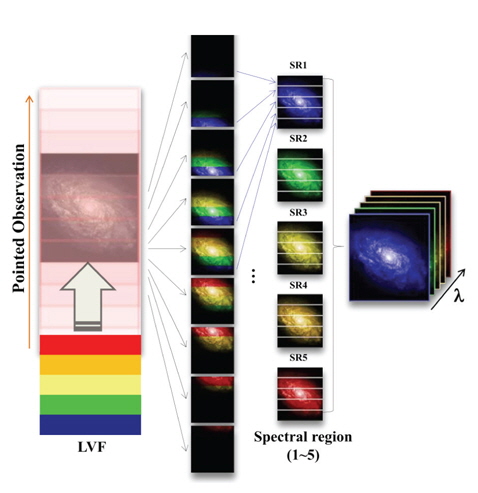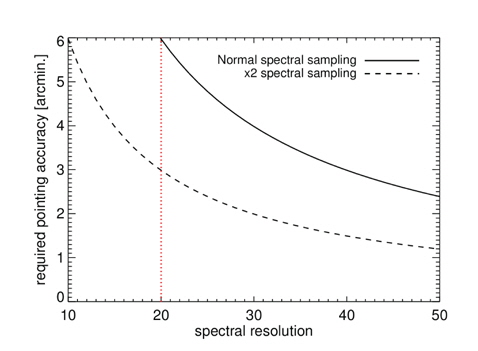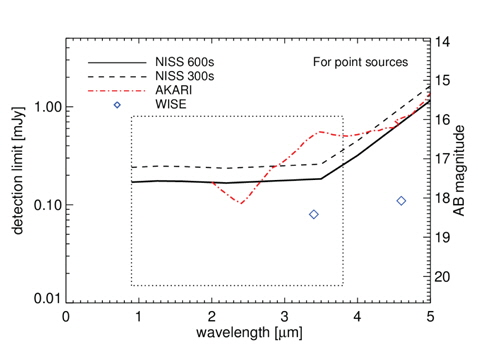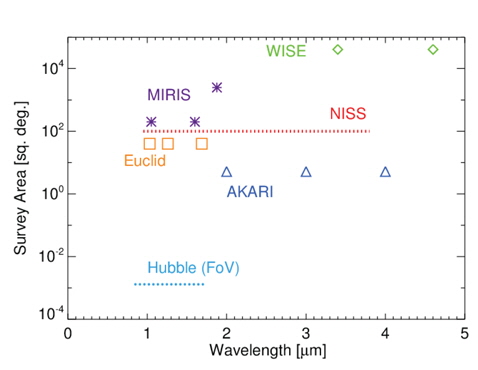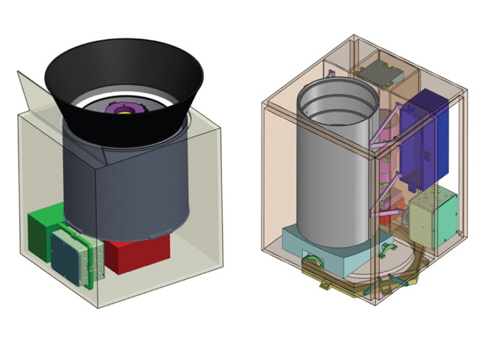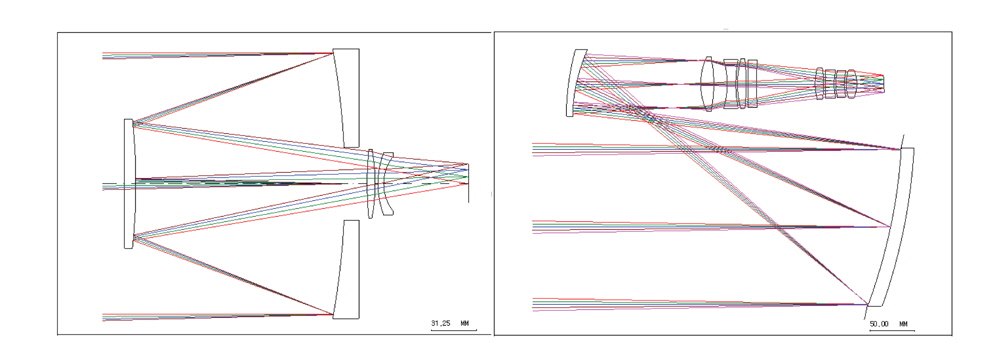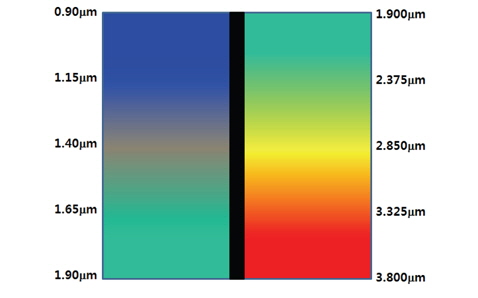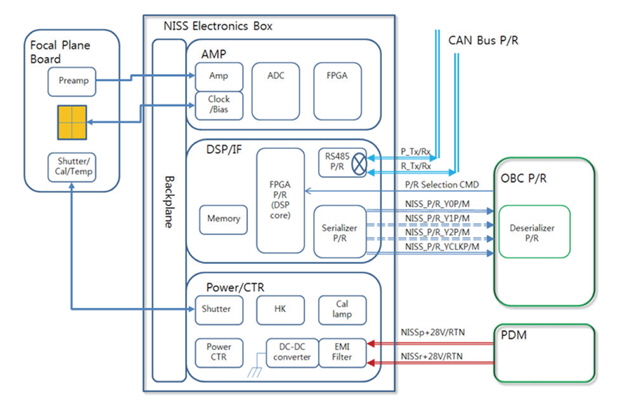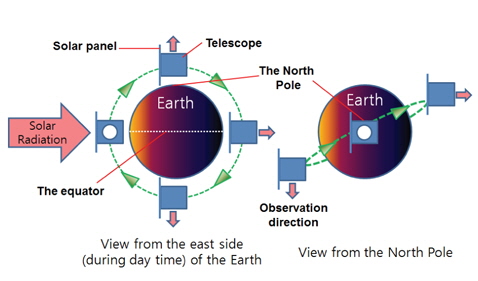



After a series of science and technology satellites (STSAT), a next generation of small satellite (NEXTSat) program for space science was started in 2012. The near-infrared imaging spectroscopic instrument proposed by Korea astronomy and space science institute (KASI) was selected as one of two scientific payloads onboard the NEXTSat-1. The near-infrared imaging spectrometer for the study of star formation history (NISS) uses linear variable filters and it is designed to perform efficient near-infrared observations in space by evading the atmospheric emissions as well as other thermal noises. The NISS performs the observation of cosmic near-infrared backgrounds in the wide wavelength ranges as well as the detection of near-infrared spectral lines in nearby galaxies, cluster of galaxies and star forming regions. It will give us less biased information on the star formation history.
KASI has the space experiences and the heritages from the previous developments of far-ultraviolet imaging spectrograph/spectroscopy of plasma evolution from astrophysical radiation (Edelstein et al. 2006) and multipurpose infrared imaging system (MIRIS) (Han et al. 2010) onboard the STSAT-1 and STSAT-3, respectively as well as cosmic infrared background experiment (CIBER) onboard the NASA’s sounding rocket as an international project (Zemcov et al. 2013). In addition, fundamental technologies of infrared systems were obtained from the development of the near-infrared camera for a ground telescope, KASI near-infrared camera system (Moon et al. 2008), which was completed successfully in 2006. It has been operated in the Bohyunsan optical astronomy observatory since 2009. KASI is preparing for the participation of the project for large infrared space telescope, space infrared telescope for cosmology and astrophysics (SPICA) (Nakagawa et al. 2012). Korea could contribute to the international collaboration project of SPICA through the development of the focal plane instrument (FPC) focal plane camera (FPC) for the near-infrared instrument onboard SPICA (Lee et al. 2012, Jeong et al. 2012). The NISS is expected to demonstrate the technology related to the development of the FPC.
This paper is organized as follows. In Section 2, the missions of NISS are overviewed. The optical, electrical and mechanical designs including the structure of telescope are described in Section 3. And the current operation and observational concepts are described in Section 4. The summary and future works are followed in Section 5.
2.1 Specifications of the NISS
Due to the limitation of mass, volume and power in the NEXTSat-1, the telescope aperture of the NISS is limited to below 20 cm. In addition, the pointing performance of the NEXTSat-1 is not optimized to observe an individual point source or to implement the moderate resolution spectroscopy. Therefore, the design concept of the NISS is focused on the observations for the compact diffuse components of the objects. To observe the broad spectral lines related to star-forming activities, a low-resolution spectroscopic function is added.
Thus, the NISS makes an efficient imaging spectroscopic survey in the near-infrared wavelength range. In order to reduce the weight and number of moving parts, the NISS uses only one filter. For the implementation of an imaging spectroscopic observation in a compact camera, a filter combined of two linear variable filters (LVF) are installed in front of the infrared detector. The circular type of LVF was already adopted in the camera onboard infrared space observatory (ISO), ISOCAM (Cesarsky et al. 1996) and has been successfully operated in the mid-infrared observation for more than 2 years. The NISS performs the near-infrared imaging spectroscopic observations in the wide wavelength range from 0.9 to 3.8 μm. Fig. 1 shows the illustration of astronomical observations with a LVF. Each pointed observation is performed at each step corresponding to a spectral resolution. The imaging at each wavelength bin can be obtained by combining all pointed observation data for an astronomical object. The specifications of the NISS are listed in Table 1.
[Table 1.] Specification of the NISS.
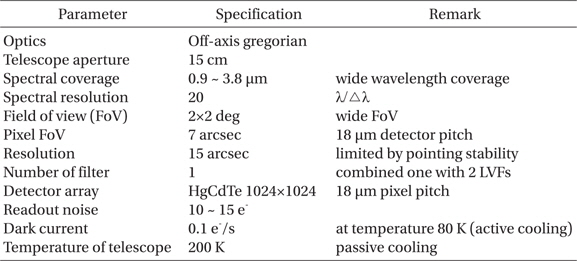
Specification of the NISS.
The spectral resolution of spectroscopy is determined considering the pointing accuracy of satellite as well as the sensitivity. Assuming a linear increase of spectral range in LVF, a fine spectral mapping requires the pointing accuracy better than 3 arcmin as seen in Fig. 2. The spatial resolution of the NISS is limited by the pointing stability of the NEXTSat-1. Considering the performance of both gyro and star tracker in the NEXTSat-1 and the data size from the observations, the spatial resolution is optimized to be around 15 arcsec. As for the reference, the pointing accuracy and the stability of the NEXTSat-1 in the optimal condition are expected to be 2.4 (2σ) and 0.2 arcmin (2σ, p-p per exposure), respectively. The pointing performance is achieved through the heritages from STSAT-1 and STSAT-3.
The instrumental parameters listed in Table 1 are used in the estimation of the sensitivity. Assuming that the emissivity of a telescope at the temperature of 200K is 2% to calculate the thermal emission, the sensitivity is estimated at 300- and 600-second integration time. The nominal integration time will be 600 seconds. Regarding the amount of background in space, the nominal value of around 1 mW/m2/sr is used which is mostly contributed from zodiacal light. It is noted that the brightness level in low background regions is around 200 nW/m2/sr. Total noise considers the photon noises from the source and the background, the dark current and the readout noises from the infrared signal to noise ratio is obtained from Eq. (1). In this estimation, In this estimation, the source confusions are not considered (e.g., Jeong et al. 2006).
where Fs is the signal from a source, Ns is the photon noise from source signal, Nbg is the photon noise from background including thermal emission from telescope, Ndark is the thermal noise from the sensor Nr is the readout noise and t is the integration time.
As shown in Fig. 3, the target sensitivity of the NISS estimated with S/N of 5 is similar to that of other space missions, although AKARI (Murakami et al. 2007) and widefield infrared survey explorer (WISE) (Wright et al. 2010) have much larger aperture size of 67 and 40 cm, respectively. Note that AKARI spectroscopy was performed in spectral resolution of ~60 and WISE was the all-sky imaging survey mission, i.e., observation with short exposure (8.8 seconds). To take the information of both image and continuous low-resolution spectrum for a target object in a sensitivity similar to other space missions is the distinctive function of the NISS.
Owing to the capability of imaging spectroscopy with a wide field of view of 2×2 deg, the NISS is optimal to cover wide areal regions and to obtain the spectral information, which enable us to study the large-scale structure of diffuse objects and the star-formation in large galaxies nearby as well as the star-forming regions. According to the current observational plan (see Section 4 in detail), the total survey area will be more than 100 square degree during the nominal life time of 2 years. As seen in Fig. 4, both the wide survey area and the broad spectral coverage give a unique dataset in the near-infrared range compared with those from other space missions. The imaging spectroscopy with the wide field of view in the near-infrared is a new attempt in space science. Note that ISOCAM onboard ISO is the mid-infrared imaging spectrometer.
The spectral information enables us to find the physical properties of objects. Table 2 shows the representative spectral lines in the near-infrared. Since the spectral lines such as Paα and polycycle aromatic hydrocarbon (PAH) are less affected by the interstellar dust extinction, those spectral lines can trace the star formation activity in nearby galaxies as less biased, the clusters of galaxies and the starforming regions, which is a key to understand the formation and the evolution of galaxies in the local Universe. UV continuum, recombination lines such as Hα, Hβ, Paα, Paβ and so on, [O II] forbidden line and far-infrared continuum are known as the representative tracers measuring the star formation rates (Kennicutt 1998). In this case, we will concentrate only on near-infrared broad and bright spectral lines which are difficult to observe in ground. Especially, the PAH emission features observed in most galactic and extragalactic sources have been studied to understand the star formations associated with dust and gas through recent space observations (Peeters et al. 2004, Calzetti et al. 2007). The measurement of star formation rates with new tracers such as PAH and Paα is essential to accurately calibrate the star formation rates in high redshift galaxies. It will be helpful to reveal the star formation history over cosmic time, although the very recent star-formations are measured from these observations.
[Table 2.] Spectral lines in the near-infrared.
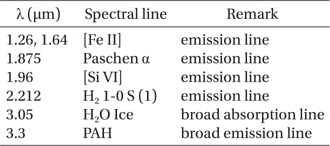
Spectral lines in the near-infrared.
The observation of cosmic infrared background (CIB) is another way to understand the star formation in a distant universe since the CIB may contain the stellar emissions from an early universe, although it gives us indirect information. The significant brightness and fluctuation of the CIB have been observed from the previous space missions (Kashlinsky et al. 2005, Thompson et al. 2007, Matsumoto et al. 2011). Although the infrared observational technology has been advanced fast, the origin of excess emissions in the near-infrared is still unclear (Fernandez et al. 2010, Cooray et al. 2012). Owing to the unique capability of imaging spectroscopic observation, the NISS can estimate the fluctuation of CIB over the cosmic time step corresponding to its spectral resolution. It will help us study the evolution of fluctuation structure and measure the absolute brightness of the CIB in the near-infrared.
Since the new objective of the NEXTSat-1 is targeted to make a compact small satellite compared with the STSAT series, the size, the mass and the power of payloads are very constrained. The requirements of the size, the mass and the power of the NEXTSat-1 are 600×600×980 mm in stowed condition, around 120 kg and 250 W, respectively. As the larger aperture of an astronomical telescope requires a longer baffle or telescope tube, it is essential to optimize the design concept considering the size limitation. As seen in Fig. 5, the NISS have adopted the off-axis design instead of the on-axis design to utilize the allocated space efficiently and to evade a stray light effectively.
The NISS optics is designed to cover the wide FoV of 2×2 deg as well as the wide wavelength range from 0.9 μm to 3.8 μm. The initial design was an 18 cm aperture reflecting telescope with the on-axis optics which is usually used in a space telescope. Due to the size requirements, quite a large secondary mirror and long relay optics were unavoidable (see the left panel of Fig. 6). The off-axis optical design is a good solution to make the most use of the limited space and to secure an optical performance (see the right panel of Fig. 6). Even though 15 cm aperture in off-axis design instead of 18 cm aperture in on-axis design is used, no obscuration by the secondary mirror in the off-axis design shows providing slightly better optical performance. In addition, the longer telescope tube and relay optics could reduce the stray light effectively. To realize the off-axis design, we have to consider the alignment and the integration of optics. Though the alignment of off-axis optics is more difficult than that of on-axis optics, a relay lens part and a primary-secondary assembly can be independently measured and integrated, since a primary-secondary assembly is an afocal type.
The lens material of good transmission in the nearinfrared range such as calcium fluoride (CaF2), zinc sulfide (ZnS) or zinc selenide (ZnSe) is used in the optical design. To perform the imaging spectroscopic observations, two LVFs are combined as a single filter (see Fig. 7). Starting from a certain wavelength, the LVF can cover almost double this wavelength. In addition, the peak wavelength varies linearly in one direction. Considering these characteristics of the LVF, the wavelength coverage with two LVFs is determined. The central region in one filter will be used for the calibration of the dark, which is crucial to detect faint signals. In order to observe the broad spectral lines the optimized spectral resolution (λ/△λ) of an LVF is determined to be 20 as shown in Table 1. Current optical designs are optimized to show similar performance in any wavelength region. According to this optical design, it is confirmed that the full width of half maximum of the point spread function is within the required resolution of 15 arcsec in all wavelength ranges.
The constraints of mechanical design are the preallocated volume and mass. The NISS volume is designed to be 290×270×400 mm. The breakdown of total mass is shown in Table 3, which is slightly lower than the allocated mass of 19 kg.
[Table 3.] Breakdown of total mass.
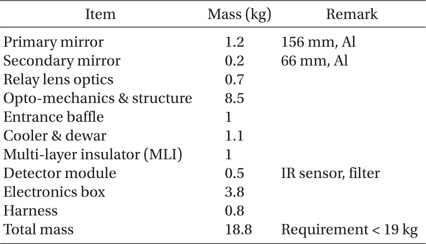
Breakdown of total mass.
Most structures including two mirrors (primary and secondary) are designed of the aluminum material which does not affect the performance even with thermal variations in the orbit. To minimize the heat load from the outside or the satellite body, the main structure is attached to the satellite body by using a bottom ring and the outer part and the dewar of the NISS are wrapped with 30 layers of multi-layer insulator. This thermal design enables the telescope and the infrared detector to be cooled down to 200 K and 80 K respectively through a radiative cooling in space and an active cooling with a small mechanical cooler. It is verified that the target temperature of the telescope and the sensor could be achieved through the thermal analysis of the NISS. The mechanical structures are designed to be protected from shocks and vibrations during launching conditions.
Fig. 8 shows the mechanical design of the NISS. The primary (M1) and the secondary (M2) mirrors are installed according to the optical path in the off-axis design. The entrance baffle is designed to evade the earth radiations as well as the solar radiations. The earth avoidance angle is less than 30 deg to reduce a thermal variation during the operation. The barrel supports the relay lenses using flexures, spacers and retainers which are heritages from MIRIS (Moon et al. 2010). It is intended to achieve the best performance even in the launching conditions as well as in the thermally unstable space conditions.
The electronics consists of two parts largely; a focal plane board and an electronics box. The focal plane board consists of an infrared detector and focal plane electronics and is located in the dewar. The electronics box has the function of warming the electronics for electrical interfaces with the spacecraft and the control of the NISS. The controller area network is used for the command and the status interfaces among the satellite, the NISS and the Serializer/Deserializer for data transfer. For the redundancy of electronics, the interfaces and power lines are designed to have backup lines. The schematic diagram for the electronics is shown in Fig. 9. Based upon the heritages from CIBER and MIRIS, the electronics parts are developed.
The NEXTSat-1 will be operated for the life time of 2 years. Since the NEXTSat-1 has two scientific payloads and several payloads for technical demonstrations, total operation time should be allocated according to the operational plan. It is scheduled to be launched in 2017. Since the NEXTSat-1 is to have a sun-synchronous orbit, the attitude control is made to evade both the sun and the earth for the purpose of passive cooling of the telescope as seen in Fig. 10. Therefore, the observations are performed near the ecliptic poles or in the shade of earth.
Except for the performance verification phase of the NEXTSat-1, the NISS will be operated 4 or 5 orbits per day for about 2 years of lifetime. It will take around two weeks to cover whole FoV in all wavelength range. The observational time per orbit for one pointed observation will be around 10 min and one observation is possible in one orbit. The observational time in one pointing is composed of dozens of exposures and one exposure time is expected to be around 10 seconds considering the required pointing stability.
Depending on the visibility of the objects, the observation targets such as nearby galaxies, clusters of galaxies, starforming regions and low background regions will be observed for the study of the cosmic star formation history. The allocated targets are shown in Table 4. The observation area for an individual target depends on the size of an object. Regarding the low background region for the CIB observation, the survey area will be more than 4 degree2 to measure the degree-scale fluctuation of the CIB. Total survey area during the life time is expected to be more than 100 degree2.
[Table 4.] Operational plan of the NISS.
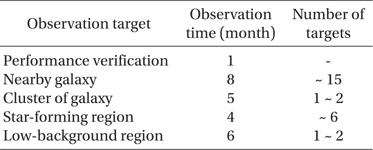
Operational plan of the NISS.
KASI is now developing the NISS, one of scientific payloads onboard the NEXTSat-1. The conceptual design study of the NISS has been finished. To satisfy the allocated volume, mass and power and scientific requirements, the NISS adopted the off-axis optics design and the imaging spectroscopy with two LVFs. The optics is optimized to cover a wide field of view as well as a wide wavelength range. The operation at cryogenic temperature is considered in the mechanical design. With the capability of imaging spectroscopy in the near-infrared, the NISS is used for the study of cosmic star formation history through the survey of large areal sky. The preliminary design review and the critical design review are scheduled in 2014 and 2015, respectively. The detailed design of the NISS will be carried out and the engineering qualification model will be also delivered in 2015.
In addition, another important role of the NISS is the demonstration of the technologies for the Korea's leading near-infrared instrument onboard the future large infrared telescope, SPICA. The imaging spectroscopic technologies in space will be tested and verified through the development of the NISS.
